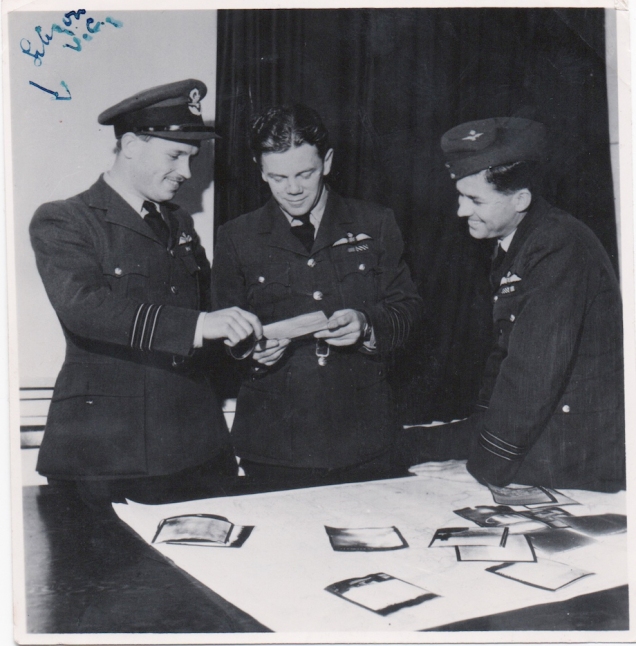
Air Marshal Sir Arthur Harris wrote the above comment on a memorandum sent to him on 14 February 1943. The memo summarised the research in Barnes Wallis’s paper ‘Air Attack on Dams’ sent to Air Ministry chiefs a few days earlier. [National Archives AIR 14/595.]
In an edition of the BBC TV Antique Roadshow programme, broadcast on 19 May 2019, the grandson of a wartime army officer, Maj H F Boddington OBE brought a collection of his grandfather’s wartime memorabilia for valuation. The programme’s expert, Mark Smith, focussed on one particular file for mention during the recording. It had been given to Maj Boddington in early 1943 by Barnes Wallis, and included a copy of Wallis’s paper ‘Air Attack on Dams’.

Several copies of this paper still exist in official files, including those available to the public in the National Archives. It has 19 pages of text, including a number of tables and footnotes, and a further eight pages of illustrations, which appear to be the ones which excited Mark Smith.
A meeting with Boddington is recorded in Wallis’s diary. Boddington had been brought in to oversee security arrangements for the forthcoming RAF trials of the Upkeep ‘bouncing bomb’ and it is likely that the paper was passed over to him then.
The paper is interesting because it was written and produced by Wallis at a crucial stage in the planning for the Dams Raid. A summary of it was discussed at an important meeting at the Air Ministry on 13 February 1943, chaired by Air Vice Marshal Ralph Sorley, the Assistant Chief of the Air Staff (Technical Requirements). This was the meeting when it was decided to bring Bomber Command into the picture, since its personnel would be required to drop the weapon from specially adapted Lancasters, and Gp Capt Charles Elworthy, a New Zealand-born officer who would go on after the war to become Chief of the Defence Staff, was deputed to brief the command’s staff.
His first contact must have been with the Bomber Command Senior Air Staff Officer, Air Vice Marshal Robert Saundby, who then wrote a lengthy memo for his boss, the AOC of Bomber Command, Air Marshal Arthur Harris. This outlined the research and testing that had gone on so far and considered the possibility of a weapon being developed for the special purpose of destroying dams, in particular the Möhne. A specially modified Lancaster would be needed and the attack would be need to be made when the dam was full or nearly full. One squadron would have to be nominated, depriving Bomber Command of its strength for ‘two or three weeks’ for training. The tactics are not difficult, Saundby concluded, somewhat optimistically. He appended a copy of Wallis’s ‘Air Attack on Dams’ paper and sent it over to Harris.
Harris was not at all convinced. He handwrote a scathing note on Saundby’s memo:
‘This is tripe of the wildest description. … there is not the smallest chance of it working. To begin with the bomb would have to be perfectly balanced around it’s [sic] axis otherwise vibration at 500RPM would wreck the aircraft or tear the bomb loose. I don’t believe a word of it’s [sic] supposed ballistics on the surface. … At all costs stop them putting aside Lancs & reducing our bombing effort on this wild goose chase. … The war will be over before it works – & it never will.’
Wallis was not defeated by this setback, perhaps knowing that Harris himself would not have the final say on the matter. Some nine days later, he was able to show Harris the films of the test drops, but the AOC was still not impressed and sent an impassioned letter to the Chief of the Air Staff, Air Chief Marshal Charles Portal. ‘All sorts of enthusiasts and panacea-mongers are now careering round MAP [the Ministry of Aircraft Production] suggesting the taking of about 30 Lancasters off the line to rig them up for this weapon, when the weapon itself exists so far only within the imaginations of those who conceived it,’ he wrote.
Portal tried to smoothe Harris’s ruffled feathers. He accepted that the weapon might come to nothing, but it was worth conducting a trial in a Lancaster to see if it could work. Portal assured Harris: ‘I will not allow more than three of your precious Lancasters to be diverted for this purpose until the full scale experiments have shown that the bomb will do what is claimed for it.’ [Harris papers, H82, RAF Museum.]
Harris reluctantly accepted Portal’s decision, and by the end of the month the operation was given the final go ahead. Further trials were now lined up, some of which Maj Boddington may well have witnessed. One must hope that his archive – which apparently contains much other interesting material unrelated to the Dams Raid – finds a safe home if it ever leaves the care of the family.
Here is the relevant clip from the programme in a rather poor quality video grab, courtesy of Richard Taylor’s Facebook page. The full programme is available for another 21 days for UK viewers here on the BBC iPlayer.
Thanks to Dr Robert Owen.
Source: John Sweetman, The Dambusters Raid, Cassell 2012, pp49-59.












